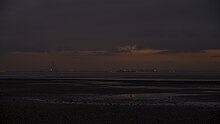Leigh-on-Sea
Leigh-on-Sea ( /ˌliː-/), commonly referred to simply as Leigh, is a town and civil parish within the city of Southend-on-Sea, located in the ceremonial county of Essex, England.Leigh-on-Sea is on the northern side of the Thames Estuary, a few miles from the open waters of the North Sea to the east, and a similar distance from the Kent coast to the south.[5] From at least the Saxon period a hilltop clearing amidst the woodland that covered much of the surrounding area (the Rochford Hundred) of Essex came to be known as Leigh (Lee in Anglo-Saxon).[6] A place of minor economic importance at the time of the Norman Conquest, a reference to Leigh (Legra) appears in the Domesday Book survey of 1086 where it lists a population of 9, in the ownership of Ranulf Peverel in the Rochford Hundred.The chancel was extended at the east end in 1872 by C. F. Haywood; Ernest Geldart added the south aisle in 1897, and there were a number of alterations made by Sir Charles Nicholson in 1913 and 1919.The tower at the west end was a prominent landmark for shipping on the Thames Estuary, and the building contains a good selection of stained glass dating from between the 18th and 20th centuries.Leigh-on-Sea has frequently been cited as one of the best places to live in the UK, owing to factors such as its proximity to London, nearby outstanding Westcliff and Southend grammar schools, good access to sports and arts activities, multiple opportunities to develop skills, and a strong sense of belonging and community spirit.[18] On 15 October 2021, Sir David Amess, the local Member of Parliament, was murdered at a constituency surgery being held in Belfairs Methodist Church in the town.





Leigh-On-Sea (song)OS grid referenceCivil parishUnitary authoritySouthend-on-SeaCeremonial countyRegionCountryEnglandSovereign statePost townPostcode districtDialling codePoliceAmbulanceEast of EnglandUK ParliamentSouthend West and Leighlittle shipsDunkirk evacuationThames EstuaryNorth SeaTwo Tree IslandcreeksThamesLondon commuter beltRomano-BritishSaxon periodNorman ConquestDomesday BookSt Clement's ChurchKentish ragstoneSir Charles NicholsonGrade II* listedHistoric EnglandPrittlewellshellfishwhitebaitbawleysMiddle AgesWilliam CamdenJohn WesleyLeigh Timesonline shoppingRightmoveSir David AmessMember of Parliamentwas murderedLeigh-on-Sea railway stationLondon, Tilbury and Southend linemarinaCanvey IslandBasildonChelmsfordLondon Southend Airportelectoral wardsParliamentDavid Burton-Sampson2011 CensusLeigh Folk FestivalregattaJohn BarberBritish LeylandLee BrilleauxPhil CornwellStephen CottrellArchbishop of YorkTina CousinsRobert DawsYorkshire Television (YTV)Medical DramaThe RoyalRobert EdenJohn FowlesPhill JupitusRobert KingDavid LloydMartyn LuckingJohn LloydMarie MacarteHelen MirrenPeggy MountJulian ParkhillVivian StanshallAlister WatsonCambridge spy ringRebecca WestMichael WildingPeter SallisWorld War IINational Heritage List for EnglandWayback MachineCeremonial countyThurrockBraintreeBrentwoodCastle PointColchesterEpping ForestHarlowMaldonRochfordTendringUttlesfordAveleyBillericayBrightlingseaBuckhurst HillBurnham-on-CrouchChadwell St MaryChigwellChipping OngarClacton-on-SeaCoggeshallCorringhamDovercourtEppingFrinton-on-SeaGreat DunmowHadleighHalsteadHarwichLoughtonManningtreePitseaPurfleet